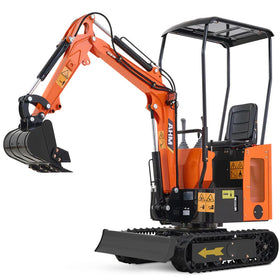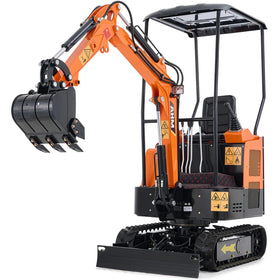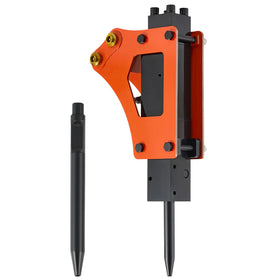Mini excavators are machines, and they tend to break down sometimes… that's normal. Here's the thing: knowing which mini excavator parts break most frequently can save you time, money, and a lot of headaches.
Understanding the most common failure points in mini excavator parts helps you plan for maintenance, stock spare components, and recognize early warning signs before catastrophic breakdowns.
Based on industry data and repair shop reports, here are the 10 mini excavator parts that fail most frequently across all mini excavator brands and models.

1. Hydraulic Seals and O-Rings
Hydraulic seals on mini excavators break easily because they face constant pressure changes, temperature fluctuations, and contamination from the dirty hydraulic fluid. Over time, rubber compounds deteriorate, and this can lead to leaks and pressure loss.
Here are five common reasons your hydraulic seals and O-rings would break easily:
- Contaminated hydraulic fluid with dirt or water
- Operating in extreme temperatures
- Rubber deterioration
- Improper hydraulic fluid types
- Excessive system pressure
Knowing how to inspect, service, and improve your hydraulic system is a crucial skill to have for the long-term survival of your mini excavator.
2. Track Chains and Rubber Tracks
Mini excavator tracks are amongst the most vulnerable parts of a mini excavator. In addition to bearing the full weight of the machine, they are used for working loads, even while navigating rough terrain.
Frequent friction with sharp rocks, debris, and improper tension means they tend to wear prematurely and may sometimes crack or even break.
Here are five reasons why your mini excavator tracks may wear down quickly:
- Incorrect track tension (too tight or loose)
- Working on sharp rocks or steel debris
- Failure to clean the undercarriage regularly
- Age-related rubber deterioration in rubber tracks
- Overloading the machine beyond capacity
In addition to knowing when to replace mini excavator tracks, you need to start by getting a mini excavator with high-quality tracks.

The AX-12B B&S Engine Mini Excavator from AHM Corps comes with an improved track frame design that reduces mud buildup and minimizes wear on the carrier rollers.
For more durability, its tracks have forged structures at key boom joints, and the shape and thickness are optimized to alleviate stress and boost longevity.
With a total width of just 3'1", it is easy to maneuver in tight urban and residential spaces. Consider this durable option if you want a versatile and durable performance.
3. Hydraulic Hoses
While in operation, your mini excavator hydraulic hoses are frequently exposed to high pressure, temperature extremes, and potential abrasion against other machine components.
Here are 5 common causes of hydraulic hoses failing, especially over a long time:
- Constant abrasion against metal surfaces
- Age-related deterioration of rubber compounds
- Pressure spikes exceeding hose ratings
- Improper routing causing excessive bending
- UV exposure degrades the outer hose layers
Monitoring and bleeding your mini-excavator hoses should always be a priority. Besides, changing mini excavator hoses must be done every 5-10 years, according to experts.
4. Bucket Teeth and Cutting Edges
Bucket teeth directly contact soil, rocks, concrete, and abrasive materials, and can get dented or broken, especially if you are digging in hard soil with your mini excavator or dealing with rocks. The constant impact and scraping action wear down even hardened steel components.
Here are five common causes of mini excavator teeth degradation:
- Normal wear from digging
- Impact with extremely hard materials
- Improper digging techniques
- Failure to replace worn teeth on time
- Operating in highly abrasive soils
The good news is that if you know how to choose and maintain mini excavator bucket teeth, you can ensure the continued use of your mini excavator bucket.
Also, being able to spot high-quality and durable mini excavator bucket teeth is very important: for smaller buckets, look for teeth made of a durable material like manganese steel.

The 200mm Narrow 8" Trenching Bucket from AHM has teeth made from high-hardness manganese steel, boasts a sturdy structure, and is capable of ensuring exceptional durability and wear resistance, even in demanding conditions.
Consider this bucket for various digging environments, including construction sites, landscaping, small demolition projects, and more.
For a smaller and more affordable option, consider the 12" Narrow Bucket Trenching Bucket, which is just as durable.
5. Final Drive Motors
The final drive or motor is a key component of a mini excavator: it does the really demanding job of transferring power to the tracks, which requires it to operate in harsh conditions with exposure to dirt, moisture, and shock loads from rough terrain.
Here are five common problems that cause final drive motors to fail on mini excavators:
- Contamination from water and debris
- Lack of proper maintenance and oil changes
- Overloading, causing excessive heat buildup
- Age-related seal failures that allow contamination
- Improper installation during previous repairs
Explore a deeper explanation of the role of the final drive in a mini excavator.
6. Air Filters and Fuel Filters
Mini excavator air filters perform the essential job of removing contaminants, which means they accumulate dirt, dust, and particles. If neglected, they can become so clogged that they become completely ineffective.
Common causes of air filters and fuel filters getting clogged on a mini excavator:
- Extended use surpassing recommended service intervals
- Operating in extremely dusty conditions
- Poor-quality replacement filters
- Contaminated fuel sources
Fortunately, changing the engine air filters on a mini excavator is not too complex or costly, as long as you follow the right steps.
7. Engine Cooling System Components
The components of the engine cooling system, like radiators, cooling fans, and water pumps, face constant temperature cycling, vibration, and potential damage from debris while maintaining critical engine temperatures.
Here are some common causes of engine cooling system components breaking down in a mini excavator.
- Clogged radiator cores from debris
- Fan blade damage from impacts
- Water pump bearing failures from age
- Thermostat failures that cause overheating
- Coolant contamination leading to corrosion
Explore these tips on fixing and preventing hydraulic system overheating in a mini excavator.

8. Hydraulic Pumps
Hydraulic pumps generate tremendous pressure and run continuously during operation. A such, they are vulnerable to internal wear, contamination, and pressure spikes, all of which can sometimes cause expensive failures.
Any of these five common issues can cause your hydraulic pumps to fail:
- The contaminated hydraulic fluid might be damaging internal components
- They might be operating with insufficient fluid levels
- Pressure relief valve failures
- Piston and cylinder wear
- Cavitation from blocked suction lines
What do do
In case of hydraulic failures, you shut down the machine immediately to prevent further damage, and do not operate until it has been fully diagnosed and repaired.
Take the following steps:
- Check for warning lights or error codes on the display
- Inspect the hydraulic fluid (check the level)
- Look for leaks or contamination
In case of insufficient fluid levels, you can easily follow these steps to add hydraulic fluid to your mini excavator. For more complicated issues, it is advisable to consult an expert.
9. Faults With Electrical Wiring and Connectors
During operation, the electrical components on a mini excavator face vibration, exposure to moisture, and temperature extremes.
Even when stored and not in use, the electrical wiring and connectors may still be exposed to potential damage from rodents or physical impact in the harsh excavator environment.
Here are five common reasons why the electrical wiring on your mini excavator may be exposed to failures or damage:
- Vibration causes wire fatigue and breaks
- Moisture intrusion can cause corrosion
- Rodent damage to exposed wiring
- Poor connection maintenance
What to Do
To keep the electrical wires and related components of your mini excavator safe, make sure you store your mini excavator in a protected area.
Also, always take the appropriate precautions when transporting your mini excavator from one place to another.
10. Boom and Arm Bushings
Mini excavator bushings enable the smooth movement of the boom and arm components while handling enormous loads and shock forces during digging.
Because of the tremendous loads they carry on a consistent basis (depending on how often you use your mini excavator), they are exposed to certain vulnerabilities:
Common causes of mini excavator boom and bushings failing or breaking:
- Normal wear and tear
- Lack of proper greasing
- Poor lubrication
- Material fatigue

What to Do
The first step to dealing with mini excavator swing boom problems is to understand what exactly the swing boom on a mini excavator is.
It is advisable to start with a high-quality mini excavator with a solid, durable, and high-performing swing boom.
In the AX-16C Mini Excavator, you get a 23 HP B&S Engine with a versatile and multi-use swing boom that allows the arm to move 52 degrees to the right and 48 degrees to the left without repositioning the machine.
Final Words
Understanding which mini excavator parts break most often is crucial for several practical reasons that directly impact your bottom line.
The 10 components we've covered - hydraulic seals, tracks, hoses, bucket teeth, final drives, filters, cooling components, pumps, electrical systems, and bushings - account for the majority of excavator breakdowns.
This knowledge will help you prevent downtime, plan, and budget, efficiently manage your inventory, and boost your performance in difficult situations.
Now that you know all that, stop letting predictable part failures disrupt your projects. Plan for these common breakdowns, stock quality replacement components, and discover how much smoother your operations become when you're prepared for the parts that break most often.







